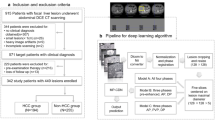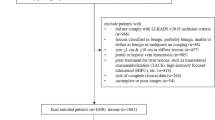Abstract
Background
The pre-operative non-invasive differential diagnosis of hepatocellular carcinoma (HCC) and intrahepatic cholangiocarcinoma (ICC) mainly depends on imaging. However, the accuracy of conventional imaging and radiomics methods in differentiating between the two carcinomas is unsatisfactory. In this study, we aimed to establish a novel deep learning model based on computed tomography (CT) images to provide an effective and non-invasive pre-operative differential diagnosis method for HCC and ICC.
Materials and methods
We retrospectively investigated the CT images of 395 HCC patients and 99 ICC patients who were diagnosed based on pathological analysis. To differentiate between HCC and ICC we developed a deep learning model called CSAM-Net based on channel and spatial attention mechanisms. We compared the proposed CSAM-Net with conventional radiomic models such as conventional logistic regression, least absolute shrinkage and selection operator regression, support vector machine, and random forest models.
Results
With respect to differentiating between HCC and ICC, the CSAM-Net model showed area under the receiver operating characteristic curve (AUC) values of 0.987 (accuracy = 0.939), 0.969 (accuracy = 0.914), and 0.959 (accuracy = 0.912) for the training, validation, and test sets, respectively, which were significantly higher than those of the conventional radiomics models (0.736–0.913 [accuracy = 0.735–0.912], 0.602–0.828 [accuracy = 0.647–0.818], and 0.638–0.845 [accuracy = 0.618–0.849], respectively. The decision curve analysis showed a high net benefit of the CSAM-Net model, which suggests potential efficacy in differentiating between HCC and ICC in the diagnosis of liver cancers.
Conclusions
The proposed CSAM-Net model based on channel and spatial attention mechanisms provides an effective and non-invasive tool for the differential diagnosis of HCC and ICC on CT images, and has potential applications in diagnosis of liver cancers.



Similar content being viewed by others
Data availability
The datasets used and analyzed during the current study are available from the corresponding author on reasonable request.
Abbreviations
- HCC:
-
Hepatocellular carcinoma
- ICC:
-
Intrahepatic cholangiocarcinoma
- CT:
-
Computed tomography
- MRI:
-
Magnetic resonance imaging
- CEUS:
-
Contrast-enhanced ultrasound
- AUC:
-
Area under the operating characteristic curve
- CNNs:
-
Convolutional neural networks
- LASSO:
-
Least absolute shrinkage and selection operator
- LR:
-
Logistic regression
- SVM:
-
Support vector machine
- RF:
-
Random forest
- GLSZM:
-
Gray-level size zone matrix
- GLRLM:
-
Gray-level run-length matrix
- GLDM:
-
Gray-level dependence matrix
- cHCC-ICC:
-
Combined HCC and ICC
References
Bloice MD, Roth PM, Holzinger A (2019) Biomedical image augmentation using augmentor. Bioinformatics 35:4522–4524. https://doi.org/10.1093/bioinformatics/btz259
Cao SE et al (2020) Multiphase convolutional dense network for the classification of focal liver lesions on dynamic contrast-enhanced computed tomography. World J Gastroenterol 26:3660–3672. https://doi.org/10.3748/wjg.v26.i25.3660
Chartrand G et al (2017) Deep learning: a primer for radiologists. Radiographics 37:2113–2131. https://doi.org/10.1148/rg.2017170077
El-Serag HB et al (2003) The continuing increase in the incidence of hepatocellular carcinoma in the United States: an update. Ann Intern Med 139:817–823. https://doi.org/10.7326/0003-4819-139-10-200311180-00009
Fiz F et al (2022) Radiomics of biliary tumors: a systematic review of current evidence. Diagnostics 12:826. https://doi.org/10.3390/diagnostics12040826
Gao YX et al (2020) Progress and prospects of biomarkers in primary liver cancer (Review). Int J Oncol 57:54–66. https://doi.org/10.3892/ijo.2020.5035
Gao R et al (2021) Deep learning for differential diagnosis of malignant hepatic tumors based on multi-phase contrast-enhanced CT and clinical data. J Hematol Oncol 14:154. https://doi.org/10.1186/s13045-021-01167-2
Gillies RJ, Kinahan PE, Hricak H (2016) Radiomics: images are more than pictures, they are data. Radiology 278:563–577. https://doi.org/10.1148/radiol.2015151169
Gong XQ et al (2021) Progress of MRI radiomics in hepatocellular carcinoma. Front Oncol 11:698373. https://doi.org/10.3389/fonc.2021.698373
Hamm CA et al (2019) Deep learning for liver tumor diagnosis part I: development of a convolutional neural network classifier for multi-phasic MRI. Eur Radiol 29:3338–3347. https://doi.org/10.1007/s00330-019-06205-9
Hosny A et al (2018) Artificial intelligence in radiology. Nat Rev Cancer 18:500–510. https://doi.org/10.1038/s41568-018-0016-5
Hu J et al (2020) Squeeze-and-excitation networks. IEEE Trans Pattern Anal Mach Intell 42:2011–2023. https://doi.org/10.1109/TPAMI.2019.2913372
Huang B et al (2016) Small intrahepatic cholangiocarcinoma and hepatocellular carcinoma in cirrhotic livers may share similar enhancement patterns at multiphase dynamic MR imaging. Radiology 281:150–157. https://doi.org/10.1148/radiol.2016151205
Jiang CJ, Zhao LW, Xin BW, Ma G, Wang XY, Song SL (2022) 18F-FDG PET/CT radiomic analysis for classifying and predicting microvascular invasion in hepatocellular carcinoma and intrahepatic cholangiocarcinoma, quantitative imaging in medicine and Surgery. Quant Imag Med Surg 12:4135–4150. https://doi.org/10.21037/qims-21-1167
Joo I, Lee JM, Yoon JH (2018) Imaging diagnosis of intrahepatic and perihilar cholangiocarcinoma: recent advances and challenges. Radiology 288:7–13. https://doi.org/10.1148/radiol.2018171187
Kang Y et al (2012) Intrahepatic mass-forming cholangiocarcinoma: enhancement patterns on gadoxetic acid-enhanced MR images. Radiology 264:751–760. https://doi.org/10.1148/radiol.12112308
Kim SA et al (2011) Intrahepatic mass-forming cholangiocarcinomas: enhancement patterns at multiphasic CT, with special emphasis on arterial enhancement pattern–correlation with clinicopathologic findings. Radiology 260:148–157. https://doi.org/10.1148/radiol.11101777
Lambin P et al (2012) Radiomics: extracting more information from medical images using advanced feature analysis. Eur J Cancer 48:441–446. https://doi.org/10.1016/j.ejca.2011.11.036
Litjens G et al (2017) A survey on deep learning in medical image analysis. Med Image Anal 42:60–88. https://doi.org/10.1016/j.media.2017.07.005
Mosadeghi S et al (2016) Sex-specific and race/ethnicity-specific disparities in cholangiocarcinoma incidence and prevalence in the USA: an updated analysis of the 2000–2011 surveillance, epidemiology and end results registry. Hepatol Res 46:669–677. https://doi.org/10.1111/hepr.12605
Nakai H et al (2021) Convolutional neural network for classifying primary liver cancer based on triple-phase CT and tumor marker information: a pilot study. Jpn J Radiol 39:690–702. https://doi.org/10.1007/s11604-021-01106-8
Nie P et al (2021) CT-Based radiomics nomogram: a potential tool for differentiating hepatocellular adenoma from hepatocellular carcinoma in the noncirrhotic liver. Acad Radiol 28:799–807. https://doi.org/10.1016/j.acra.2020.04.027
Petrowsky H et al (2020) Modern therapeutic approaches for the treatment of malignant liver tumours. Nat Rev Gastroenterol Hepatol 17:755–772. https://doi.org/10.1038/s41575-020-0314-8
Rahib L et al (2014) Projecting cancer incidence and deaths to 2030: the unexpected burden of thyroid, liver, and pancreas cancers in the United States. Cancer Res 74:2913–2921. https://doi.org/10.1158/0008-5472.can-14-0155
Rimola J et al (2009) Cholangiocarcinoma in cirrhosis: absence of contrast washout in delayed phases by magnetic resonance imaging avoids misdiagnosis of hepatocellular carcinoma. Hepatology 50:791–798. https://doi.org/10.1002/hep.23071
Sun L et al (2021) Attention-embedded complementary-stream CNN for false positive reduction in pulmonary nodule detection. Comput Biol Med 133:104357. https://doi.org/10.1016/j.compbiomed.2021.104357
Sung H et al (2021) Global cancer statistics 2020: GLOBOCAN estimates of incidence and mortality worldwide for 36 cancers in 185 countries. CA Cancer J Clin 71:209–249. https://doi.org/10.3322/caac.21660
Tian C et al (2020) Attention-guided CNN for image denoising. Neural Netw 124:117–129. https://doi.org/10.1016/j.neunet.2019.12.024
Van Griethuysen JJM et al (2017) Computational radiomics system to decode the radiographic phenotype. Cancer Res 77:e104–e107. https://doi.org/10.1158/0008-5472.can-17-0339
Yasaka K et al (2018) Deep learning with convolutional neural network for differentiation of liver masses at dynamic contrast-enhanced CT: a preliminary study. Radiology 286:887–896. https://doi.org/10.1148/radiol.2017170706
Yuan MX et al (2016) Factors affecting the enhancement patterns of intrahepatic cholangiocarcinoma (ICC) on contrast-enhanced ultrasound (CEUS) and their pathological correlations in patients with a single lesion. Ultraschall Med 37:609–618. https://doi.org/10.1055/s-0034-1399485
Yushkevich PA et al (2006) User-guided 3D active contour segmentation of anatomical structures: significantly improved efficiency and reliability. Neuroimage 31:1116–1128. https://doi.org/10.1016/j.neuroimage.2006.01.015
Acknowledgements
We thank the Department of Pathology of the First Affiliated Hospital of Nanchang University for helping us to collect pathological data.
Funding
This research received no external funding.
Author information
Authors and Affiliations
Contributions
Conception and design of the research: JH, YS, ZW, HZ, JW, K-HZ. Acquisition of data: JH, GX, XZ. Analysis and interpretation of the data: ZW, HZ, XZ. Statistical analysis: YS, GX, JW, K-HZ. Writing of the manuscript: JH, YS, ZW, HZ. Critical revision of the manuscript for intellectual content: JW, K-HZ. All authors read and approved the final draft.
Corresponding authors
Ethics declarations
Conflict of interest
The authors declare no conflict of interest.
Ethical approval
This study was conducted in accordance with the declaration of Helsinki.This study was conducted with approval from the Ethics Committee of First Affiliated Hospital of Nanchang University (2022)CDYFYYLK(08-014).A written informed consent was obtained from all participants.
Institutional review board statement
This retrospective study was approved by the Ethics Committee of the First Affiliated Hospital of Nanchang University.
Informed consent
Informed consent was obtained from all subjects involved in the study. Written informed consent was obtained from the patients to publish this paper.
Additional information
Publisher's Note
Springer Nature remains neutral with regard to jurisdictional claims in published maps and institutional affiliations.
Rights and permissions
Springer Nature or its licensor (e.g. a society or other partner) holds exclusive rights to this article under a publishing agreement with the author(s) or other rightsholder(s); author self-archiving of the accepted manuscript version of this article is solely governed by the terms of such publishing agreement and applicable law.
About this article
Cite this article
Huang, Jl., Sun, Y., Wu, Zh. et al. Differential diagnosis of hepatocellular carcinoma and intrahepatic cholangiocarcinoma based on spatial and channel attention mechanisms. J Cancer Res Clin Oncol 149, 10161–10168 (2023). https://doi.org/10.1007/s00432-023-04935-4
Received:
Accepted:
Published:
Issue Date:
DOI: https://doi.org/10.1007/s00432-023-04935-4




